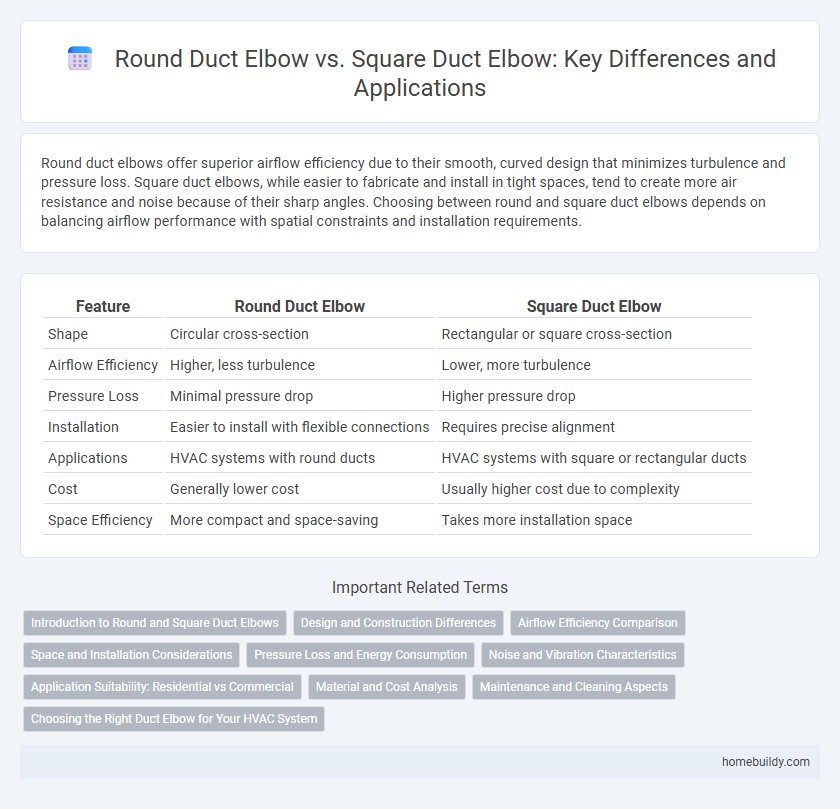Round duct elbows offer superior airflow efficiency due to their smooth, curved design that minimizes turbulence and pressure loss. Square duct elbows, while easier to fabricate and install in tight spaces, tend to create more air resistance and noise because of their sharp angles. Choosing between round and square duct elbows depends on balancing airflow performance with spatial constraints and installation requirements.
Table of Comparison
| Feature | Round Duct Elbow | Square Duct Elbow |
|---|---|---|
| Shape | Circular cross-section | Rectangular or square cross-section |
| Airflow Efficiency | Higher, less turbulence | Lower, more turbulence |
| Pressure Loss | Minimal pressure drop | Higher pressure drop |
| Installation | Easier to install with flexible connections | Requires precise alignment |
| Applications | HVAC systems with round ducts | HVAC systems with square or rectangular ducts |
| Cost | Generally lower cost | Usually higher cost due to complexity |
| Space Efficiency | More compact and space-saving | Takes more installation space |
Introduction to Round and Square Duct Elbows
Round duct elbows offer streamlined airflow and reduced pressure loss due to their curved design, making them ideal for HVAC systems prioritizing efficiency and noise reduction. Square duct elbows provide easier installation and compatibility with rectangular ductwork, offering structural stability and efficient space utilization in commercial and industrial settings. Both types serve specific needs in ventilation systems, with round elbows focusing on aerodynamic performance and square elbows emphasizing practicality and integration.
Design and Construction Differences
Round duct elbows feature a smooth, curved design that minimizes airflow resistance and reduces noise, making them ideal for high-efficiency ventilation systems. Square duct elbows have sharp, angular turns that may cause increased turbulence and pressure loss but offer easier fabrication and installation in tight spaces. Construction-wise, round elbows are typically made from cylindrical sheets rolled and welded, while square elbows consist of flat panels joined at right angles, affecting both material use and structural rigidity.
Airflow Efficiency Comparison
Round duct elbows provide superior airflow efficiency compared to square duct elbows due to their smooth curvature, which reduces turbulence and pressure drops. Square duct elbows create more air resistance because of sharper angles and increased friction at the corners, leading to higher energy consumption in HVAC systems. Engineers often prefer round duct elbows in high-efficiency ventilation designs to optimize airflow performance and minimize operational costs.
Space and Installation Considerations
Round duct elbows require less space due to their streamlined shape, facilitating easier installation in tight areas and reducing airflow resistance. Square duct elbows, while bulkier, offer simpler connection points with standard square ducting but may necessitate more clearance and additional support during installation. Choosing between round and square elbows depends on spatial constraints and the specific ductwork configuration for optimal fit and efficiency.
Pressure Loss and Energy Consumption
Round duct elbows exhibit lower pressure loss compared to square duct elbows due to their streamlined curvature, which minimizes turbulence and preserves airflow velocity. This reduced pressure loss directly decreases the energy consumption required by HVAC systems to maintain desired airflow rates. In contrast, square duct elbows generate higher resistance and increased energy costs, making round ducts more efficient for energy conservation and system performance.
Noise and Vibration Characteristics
Round duct elbows exhibit superior noise and vibration characteristics compared to square duct elbows due to their smoother airflow transition and reduced turbulence, which minimizes acoustic energy and mechanical vibration. The continuous curvature of round elbows reduces pressure losses and limits vibration-induced noise, making them preferable in HVAC systems where sound attenuation is critical. In contrast, square duct elbows generate higher noise levels and vibrations because of sharp corners and airflow separation, leading to increased turbulence and structural stress.
Application Suitability: Residential vs Commercial
Round duct elbows offer smoother airflow and reduced noise, making them ideal for residential HVAC systems where comfort and quiet operation are priorities. Square duct elbows are preferred in commercial settings due to their ease of installation in tight spaces and compatibility with larger, modular ductwork. Selecting the appropriate duct elbow type enhances system efficiency and meets the specific airflow demands of residential or commercial applications.
Material and Cost Analysis
Round duct elbows typically use galvanised steel or aluminium, offering better airflow due to smoother curves and less resistance, which can reduce energy costs over time. Square duct elbows are often constructed from sheet metal or stainless steel, generally incurring higher fabrication costs due to labor-intensive manufacturing and increased material waste. Material durability and initial installation expenses make round elbows more cost-effective for HVAC systems aimed at efficiency and long-term savings.
Maintenance and Cleaning Aspects
Round duct elbows feature smooth, curved surfaces that reduce accumulation of dust and debris, making maintenance and cleaning more efficient compared to square duct elbows. Square duct elbows have sharp corners and flat surfaces where dirt and contaminants can easily build up, requiring more frequent and intensive cleaning efforts. The streamlined design of round elbows also facilitates better airflow, minimizing the need for frequent maintenance due to blockages.
Choosing the Right Duct Elbow for Your HVAC System
Choosing the right duct elbow for your HVAC system depends on airflow efficiency and installation space; round duct elbows offer smoother airflow with less resistance, improving system performance and energy efficiency. Square duct elbows, while easier to fabricate and install in tight or rectangular spaces, tend to generate more turbulence due to their sharp angles, potentially reducing air pressure and increasing noise levels. Selecting between round and square elbows should consider factors such as duct size, HVAC layout, and desired airflow characteristics to optimize system longevity and comfort.
Round duct elbow vs Square duct elbow Infographic

 homebuildy.com
homebuildy.com